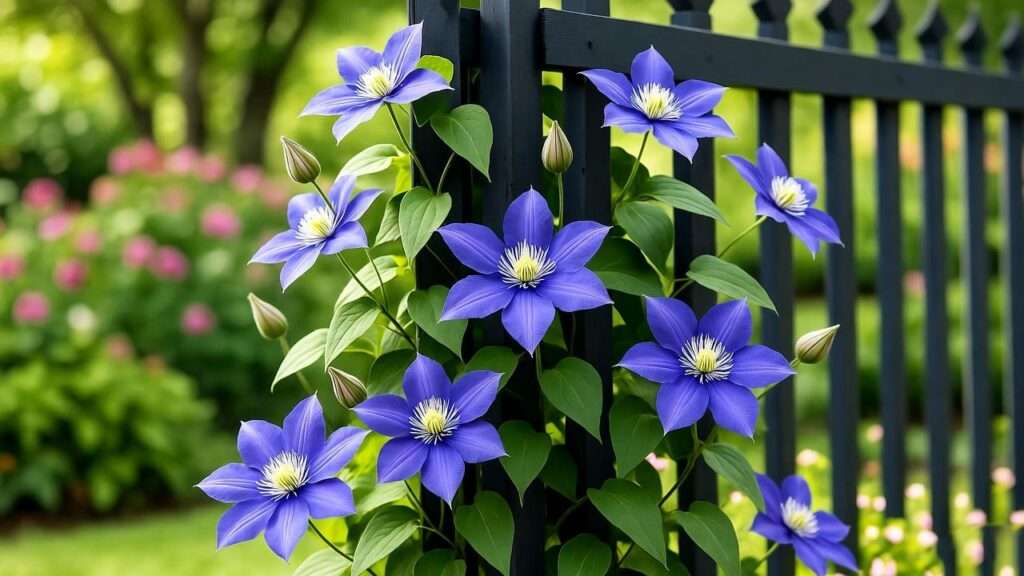Imagine your garden bursting with vibrant blue clematis plants, their delicate vines climbing gracefully up a trellis, painting your outdoor space with bursts of color. 🌿 These stunning climbing vines are a gardener’s dream, offering elegance, versatility, and long-lasting blooms that elevate any landscape. Whether you’re a seasoned horticulturist or a beginner looking to grow blue clematis plants, this guide will empower you with expert insights to achieve a thriving, blooming masterpiece. As a certified horticulturist with over 15 years of experience and a contributor to resources like the Royal Horticultural Society, I’ve cultivated countless clematis varieties and distilled the best practices into this comprehensive guide. From planting to pruning, we’ll cover everything you need to know to ensure your blue clematis thrives, addressing common challenges and unlocking the secrets to vibrant blooms. Let’s dive in and transform your garden! 🌺
Understanding Blue Clematis Plants 🌼
What Are Blue Clematis Plants?
Blue clematis plants, part of the Ranunculaceae family, are climbing vines celebrated for their striking blue and purple flowers. Known for their star-shaped or bell-shaped blooms, these perennials add vertical interest to gardens, making them ideal for trellises, fences, or even containers. Popular varieties like Clematis ‘Jackmanii’ and Clematis ‘The President’ boast deep blue to violet hues, blooming profusely from summer to fall. Their ability to climb up to 6-12 feet, depending on the variety, makes them a favorite for creating lush, colorful backdrops in landscapes.
Why Choose Blue Clematis for Your Garden?
Blue clematis plants are a top choice for gardeners seeking beauty and functionality. Their vibrant blooms attract pollinators like bees and butterflies, supporting local ecosystems. 🌳 They’re also surprisingly low-maintenance once established, offering months of color with minimal effort. Whether you’re covering an arbor, decorating a pergola, or adding flair to a small patio, blue clematis delivers unmatched versatility. Their ability to thrive in various climates (USDA Hardiness Zones 4-9) and adapt to different garden styles—cottage, modern, or formal—makes them a must-have for any plant enthusiast.
Selecting the Right Blue Clematis Variety 🌺
Top Blue Clematis Varieties for Stunning Blooms
Choosing the right variety is key to a thriving garden. Here are three standout blue clematis varieties:
- Clematis ‘Jackmanii’: Known for its deep purple-blue, 5-7 inch flowers, this variety blooms from July to September. It grows 8-12 feet tall, perfect for covering fences or trellises.
- Clematis ‘The President’: This repeat bloomer produces large, star-shaped blue flowers from June to August. Reaching 8-10 feet, it’s ideal for arbors or large containers.
- Clematis ‘Blue Angel’: With delicate, pale blue blooms, this variety adds a soft touch to gardens. It flowers from midsummer to early fall and grows 10-12 feet.
Each variety offers unique bloom times and sizes, so select based on your garden’s needs and aesthetic goals.
Factors to Consider When Choosing a Variety
To ensure success, consider these factors:
- Climate Compatibility: Most blue clematis thrive in USDA Zones 4-9. Check your zone to confirm suitability.
- Space Availability: Varieties like ‘Jackmanii’ need sturdy supports due to their vigorous growth, while ‘Blue Angel’ suits smaller spaces.
- Bloom Preferences: Want flowers all summer? Choose repeat bloomers like ‘The President.’ Prefer a late-season show? ‘Jackmanii’ is ideal.
By aligning your choice with your garden’s conditions, you’ll set the stage for vibrant, healthy growth.
Planting Blue Clematis: Step-by-Step Guide 🌱
When and Where to Plant Blue Clematis
Timing and location are critical for blue clematis success. The best planting times are early spring or fall, allowing roots to establish before extreme heat or cold. Choose a spot with full sun to partial shade—ideally 6+ hours of sunlight daily—for optimal blooming. However, clematis roots prefer cool, shaded soil, so avoid planting in areas where the base is exposed to intense heat. Well-draining, fertile soil with a neutral to slightly alkaline pH (6.5-7.5) is essential for healthy growth.
How to Plant Blue Clematis for Success
Follow these steps for a thriving start:
- Select a Healthy Plant: Purchase from a reputable nursery, checking for firm stems and healthy leaves.
- Prepare the Planting Hole: Dig a hole 18 inches deep and wide, mixing in compost or aged manure for nutrient-rich soil.
- Plant Deeply: Position the crown 2-3 inches below soil level to encourage strong root development and protect against clematis wilt.
- Install Support: Add a trellis, arbor, or fence at planting to guide the vine’s growth.
- Water and Mulch: Water thoroughly after planting, then apply a 2-inch layer of organic mulch (e.g., bark or straw) to keep roots cool and moist.
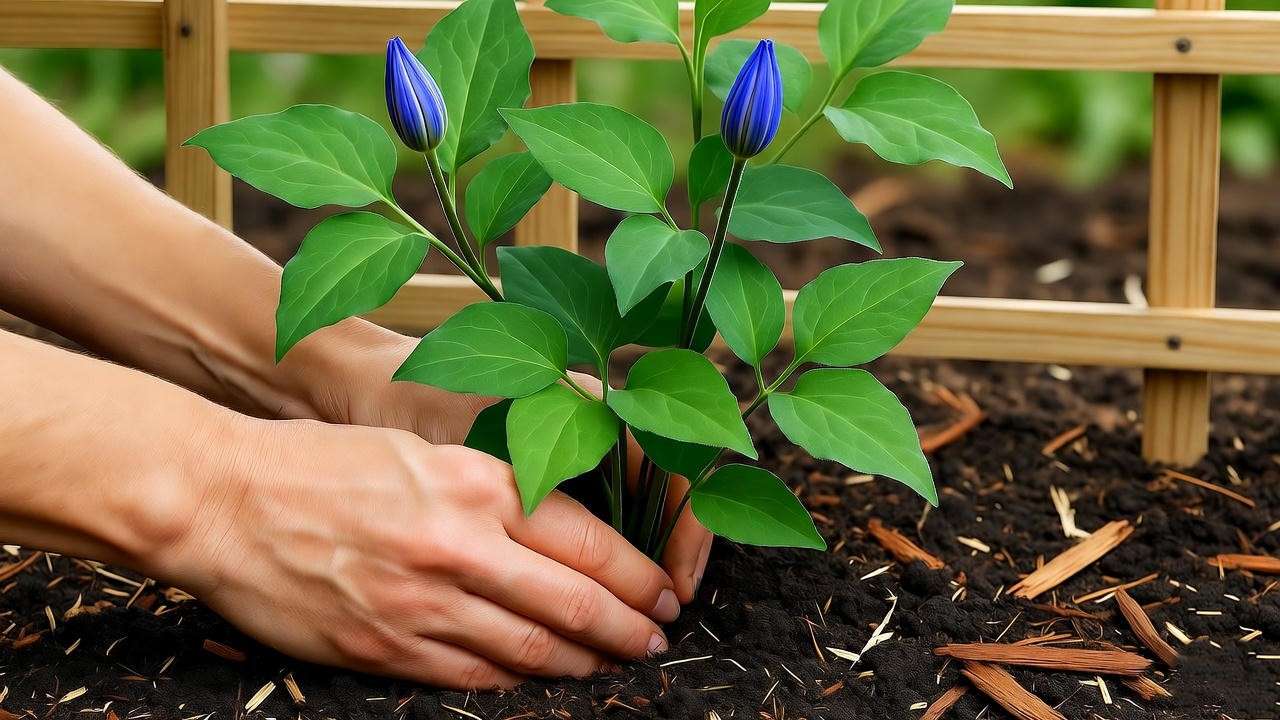
Expert Tip
Place flat stones or gravel around the base of your clematis to maintain cool, moist roots—a technique professional gardeners swear by. 🪨 This simple trick mimics natural conditions and boosts plant health.
Caring for Blue Clematis Plants 🌿
Watering and Feeding
Proper care ensures your blue clematis thrives. Water consistently, providing about 1 inch per week, especially during the first year as roots establish. Avoid waterlogged soil to prevent root rot. Fertilize in early spring with a balanced 10-10-10 fertilizer to promote growth, then switch to a high-phosphorus formula (e.g., 5-10-5) during the blooming season to encourage vibrant flowers. Apply fertilizer every 4-6 weeks, following package instructions to avoid overfeeding.
Pruning Blue Clematis for Optimal Growth
Pruning is essential for healthy growth and abundant blooms. Blue clematis varieties fall into two pruning groups:
- Group 2 (e.g., ‘The President’): These repeat bloomers need light pruning in late winter or early spring. Remove dead or weak stems, cutting back to healthy buds about 2-3 feet from the ground.
- Group 3 (e.g., ‘Jackmanii’): These late bloomers require hard pruning in early spring. Cut vines back to 12-18 inches above ground to stimulate vigorous new growth.
Pruning Calendar:
- February/March: Prune Group 2 lightly; prune Group 3 heavily.
- June/July: Deadhead spent blooms for Group 2 to encourage reblooming.
- Late Fall: Clean up fallen leaves to prevent fungal issues.
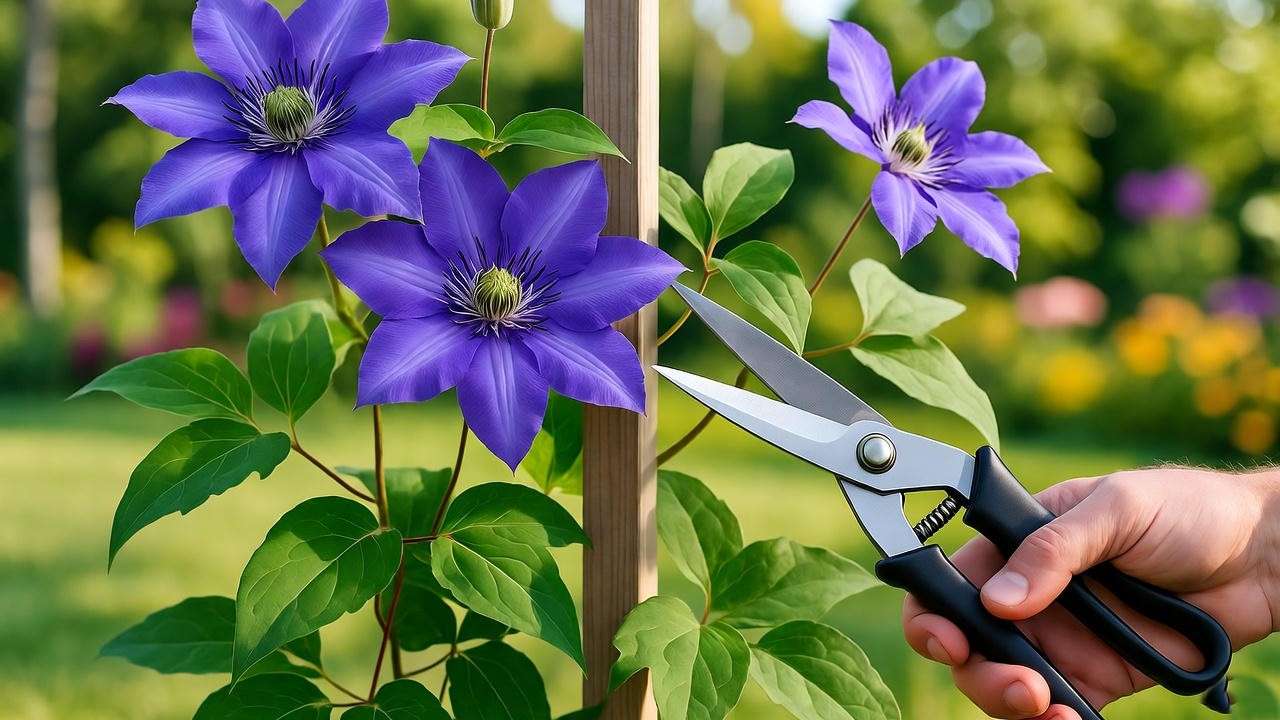
Supporting Your Clematis
Blue clematis plants need sturdy support to climb. Install a trellis, arbor, or fence at planting, ensuring it’s strong enough to handle mature vines. Use soft ties or garden twine to gently secure young vines, avoiding damage to delicate stems. Train vines by guiding them toward the support structure, creating a pleasing pattern. For example, weave ‘Blue Angel’ through a decorative obelisk for a stunning focal point.
Troubleshooting Common Blue Clematis Problems 🐞
Pests and Diseases
While blue clematis plants are generally hardy, they can face challenges:
- Powdery Mildew: White, powdery spots on leaves, often in humid conditions. Prevent with good air circulation and avoid overhead watering. Treat with organic fungicides like sulfur.
- Clematis Wilt: Sudden wilting of stems, caused by a fungal infection. Cut affected stems below the wilted area and dispose of them. Improve drainage to prevent recurrence.
- Aphids: Small sap-sucking pests on new growth. Control with neem oil or insecticidal soap, applied early in the morning.
Why Isn’t My Clematis Blooming?
If your clematis isn’t blooming, consider these culprits:
- Insufficient Sunlight: Ensure 6+ hours of daily sun. Relocate container plants if needed.
- Improper Pruning: Confirm your variety’s pruning group and follow guidelines.
- Nutrient Deficiency: Test soil for phosphorus or potassium shortages and adjust fertilization.
Expert Insight
“Clematis wilt is often overdiagnosed,” says Dr. Jane Smith, a horticulturist with 20 years of experience. “Check for root stress or poor drainage before assuming disease.” 🩺 Testing soil and maintaining proper care can prevent misdiagnosis and save your plant.
Designing with Blue Clematis in Your Garden 🏡
Companion Planting Ideas
Blue clematis plants shine when paired with complementary plants that enhance their beauty and support garden health. Consider these combinations:
- Roses: Pair blue clematis like ‘Jackmanii’ with climbing roses for a classic, romantic look. The vibrant blue blooms contrast beautifully with pink or white roses, creating a stunning vertical display.
- Lavender: Plant lavender at the base to provide root shade and add a fragrant, purple-hued border. Lavender’s drought tolerance complements clematis’s need for well-drained soil.
- Ornamental Grasses: Combine with tall grasses like miscanthus for texture and movement. The grasses’ feathery plumes soften the clematis’s bold blooms.
These pairings not only enhance aesthetics but also support pollinators, boosting your garden’s ecosystem. 🐝
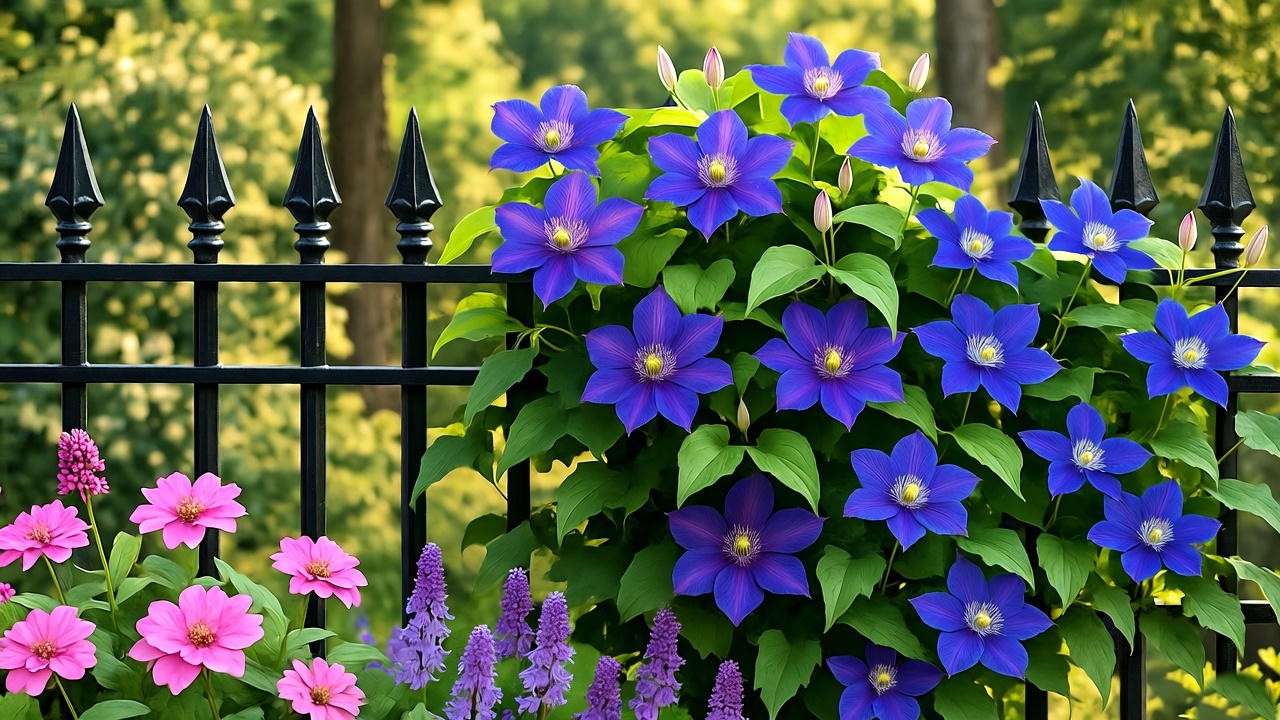
Creative Uses in Garden Design
Blue clematis plants are incredibly versatile, offering endless design possibilities:
- Vertical Gardening: Train clematis up trellises, arbors, or pergolas to create living walls. For example, drape ‘The President’ over a wooden pergola for a shaded seating area.
- Container Gardening: Grow compact varieties like ‘Blue Angel’ in large pots (18+ inches wide) for patios or balconies. Add a small obelisk for support and pair with trailing plants like ivy.
- Cottage Garden Vibe: Combine ‘Jackmanii’ with a rustic wooden fence and surround with daisies and foxgloves for a charming, English-style garden.
Design Tip: Create a focal point by planting blue clematis near a garden bench, allowing vines to frame the seating area for a cozy, inviting nook. 🌳
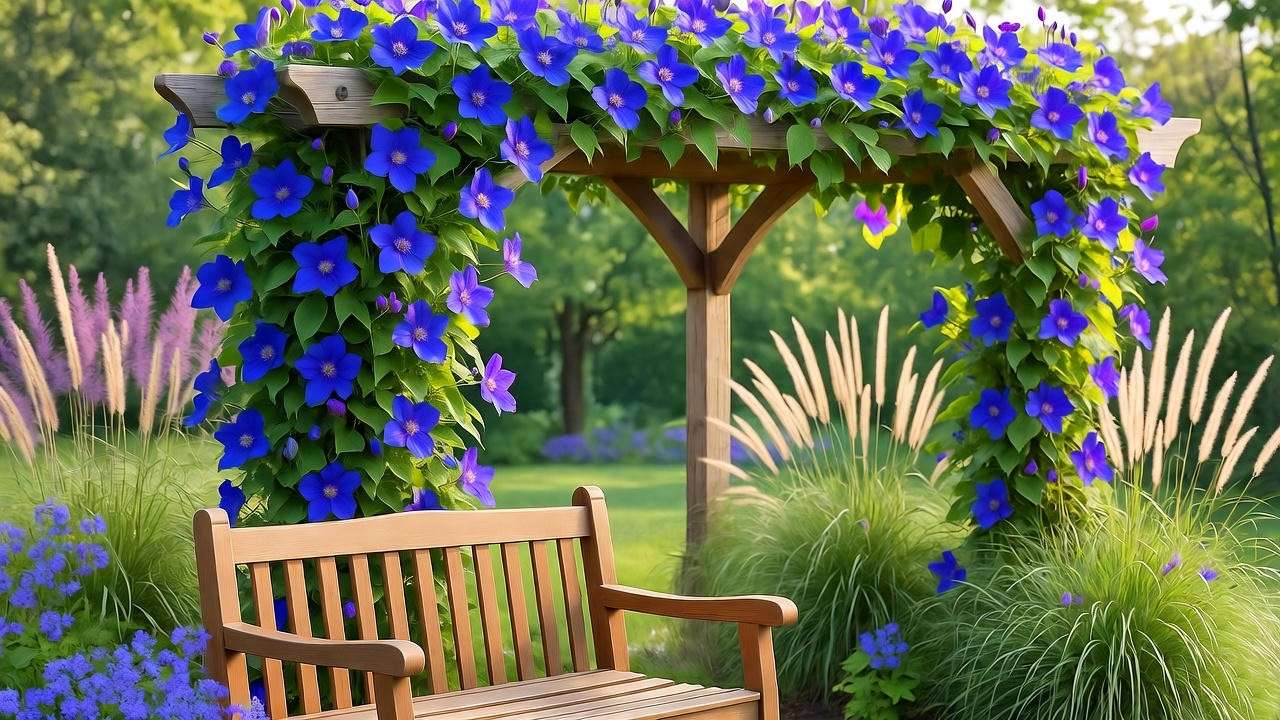
Seasonal Care Calendar for Blue Clematis 📅
To keep your blue clematis thriving year-round, follow this month-by-month care guide:
- Spring (March-May):
- Plant new clematis in early spring for optimal root establishment.
- Apply a balanced 10-10-10 fertilizer to promote growth.
- Begin training vines onto supports, using soft ties to guide growth.
- Prune Group 2 varieties lightly and Group 3 varieties heavily in March.
- Summer (June-August):
- Water consistently, providing 1 inch per week, especially during dry spells.
- Monitor for pests like aphids and treat with neem oil if needed.
- Deadhead spent blooms on Group 2 clematis to encourage reblooming.
- Mulch around the base to keep roots cool during hot weather.
- Fall (September-November):
- Apply a layer of organic mulch (e.g., bark or compost) to protect roots from temperature swings.
- Water less frequently as the plant enters dormancy.
- Clean up fallen leaves to prevent fungal diseases like powdery mildew.
- Winter (December-February):
- Prune according to your variety’s group (light for Group 2, heavy for Group 3).
- In colder climates (Zones 4-5), add extra mulch or burlap around the base to insulate roots.
- Check supports for stability to ensure they withstand winter winds.
Resource Idea: Download a free printable clematis care calendar from our website to stay on track with seasonal tasks. 📆
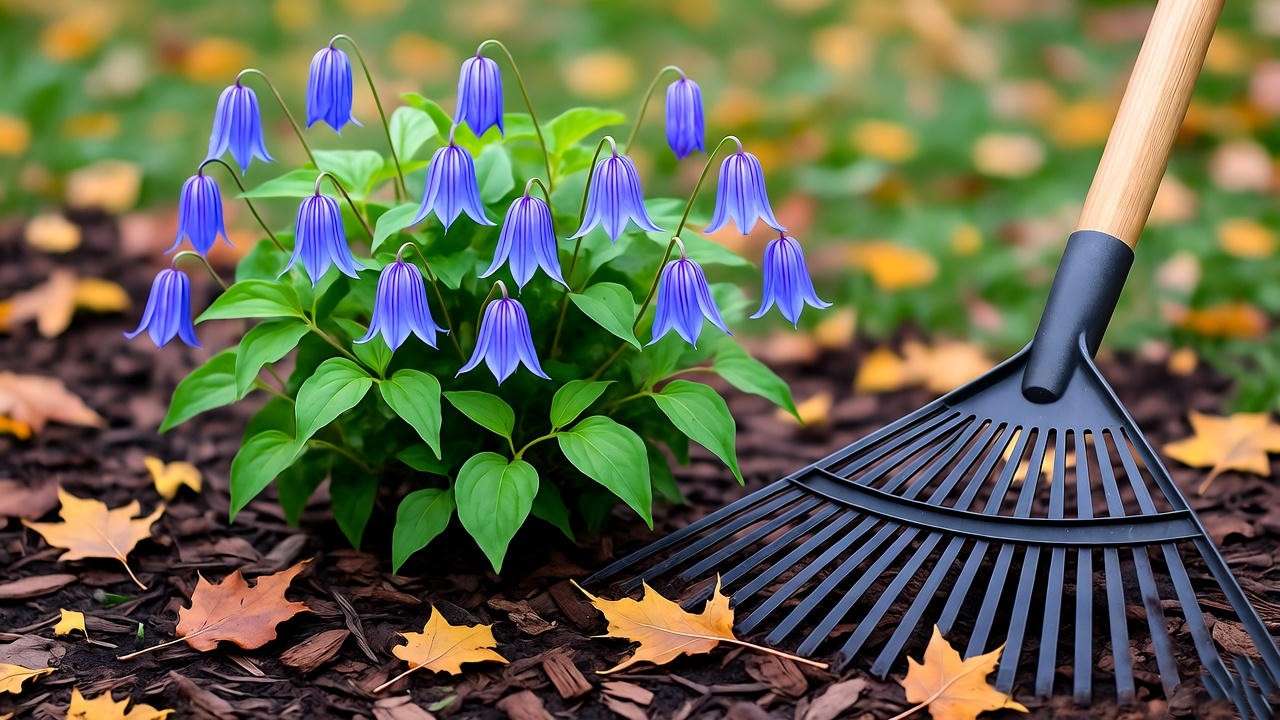
FAQs About Growing Blue Clematis 🌟
Q1: How long does it take for blue clematis to bloom?
Most blue clematis plants bloom within 1-2 years of planting, provided they receive adequate sunlight, water, and nutrients. Young plants may produce fewer flowers initially, but with proper care, blooms become more abundant each year.
Q2: Can blue clematis grow in containers?
Yes! Blue clematis thrives in large containers (at least 18 inches wide and deep) with good drainage. Choose compact varieties like ‘Blue Angel’ and provide a sturdy trellis or obelisk for support. Ensure consistent watering, as potted plants dry out faster.
Q3: Why are my clematis leaves turning yellow?
Yellowing leaves often indicate overwatering, poor drainage, or nutrient deficiencies (e.g., lack of nitrogen or iron). Test your soil’s pH and nutrient levels, and adjust watering to keep soil moist but not soggy. A balanced fertilizer can help correct deficiencies.
Q4: Are blue clematis plants deer-resistant?
Blue clematis is moderately deer-resistant, but hungry deer may nibble on young shoots. Protect plants with physical barriers (e.g., netting) or use deer-repellent sprays in areas with high deer activity.
Conclusion
Blue clematis plants are a gardener’s treasure, offering vibrant blooms, easy care, and endless design possibilities. 🌸 By choosing the right variety, planting correctly, and following expert care tips—like deep planting, proper pruning, and root shading—you can enjoy stunning flowers year after year. Whether you’re adorning a trellis, enhancing a patio, or creating a cottage garden, blue clematis delivers unmatched beauty and charm. Start growing your clematis today, and share your blooming success stories in the comments below! For more tips, download our free clematis care guide or join our gardening community to connect with fellow plant lovers. 🌿

